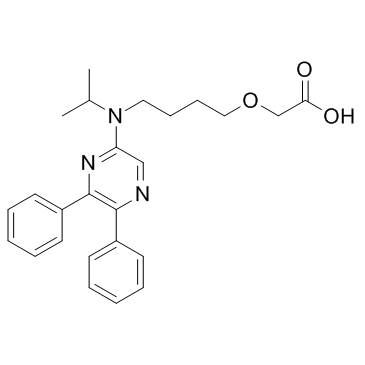| Cas No.: | 475085-57-5 |
| Chemical Name: | ACT-333679; MRE269; MRE 269; ACT333679; ACT 333679 |
| Synonyms: | ACT-333679; MRE269; MRE 269; ACT333679; ACT 333679 |
| SMILES: | OC(COCCCCN(C(C)C)C1=NC(C2=CC=CC=C2)=C(C3=CC=CC=C3)N=C1)=O |
| Formula: | C25H29N3O3 |
| M.Wt: | 419.52 |
| Sotrage: | 2 years -20°C Powder, 2 weeks 4°C in DMSO, 6 months -80°C in DMSO |
| Description: | MRE-269 is an active metabolite of selexipag, and acts as a selective IP receptor agonist. |
| In Vivo: | The vasorelaxant effects of MRE-269 on rat small intralobar pulmonary artery (SIPA) and EPA are the same, while the other IP receptor agonists induce less vasodilation in SIPA than in EPA[1]. MRE-269 produces substantial relaxation of rat small pulmonary artery, although its effects are only significant at high concentrations of above 10 μM (pEC50, 4.98±0.22). By contrast, in rat small pulmonary veins, MRE-269 only produces minimal relaxation over the whole concentration range, with only significant relaxation occurring at the two highest doses of MRE-269 of 10 and 100 μM[2]. |
| In Vitro: | MRE-269 induces endothelium-independent vasodilation of rat extralobar pulmonary artery (EPA). MRE-269 or other IP receptor agonists including epoprostenol, iloprost, treprostinil and beraprost increase cAMP levels in hPASMC[1]. MRE-269 induces concentration-dependent vasodilation in LPA(+), LPA(-), and SPA(-)[3]. |

 To enhance service speed and avoid tariff delays, we've opened a US warehouse. All US orders ship directly from our US facility.
To enhance service speed and avoid tariff delays, we've opened a US warehouse. All US orders ship directly from our US facility.




















